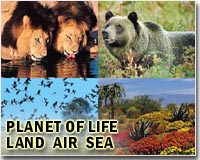 |
Nashville TN (SPX) Feb 07, 2011 Since the days of Darwin, the "tree of life" has been the preeminent metaphor for the process of evolution, reflecting the gradual branching and changing of individual species. The discovery that a large cluster of genes appears to have jumped directly from one species of fungus to another, however, significantly strengthens the argument that a different metaphor, such as a mosaic, may be more appropriate. "The fungi are telling us something important about evolution ... something we didn't know," said Antonis Rokas, assistant professor of biological sciences at Vanderbilt. He and research associate Jason Slot reported their discovery in the Jan. 25 issue of the journal Current Biology. Rokas and Slot discovered that millions of years ago, a cluster of 23 genes jumped from one strain of mold commonly found on starchy foods like bread and potatoes, Aspergillus, to another strain of mold that lives in herbivore dung and specializes in breaking down plant fibers, Podospora. The findings came as a major surprise, as there are only a handful of cases in recent evolutionary history where this type of gene transfer between organisms, known as horizontal gene transfer, has been reported in complex cells like those found in plants, animals and fungi. "Because most people didn't believe that such large gene clusters could be transferred horizontally, they haven't looked for them and they haven't been found," Rokas said. Rokas and Slot detected the unprecedented gene cluster transfer during a detailed comparison of the entire genomes of nearly 100 species of fungi. The primary goal of their research is to identify the most reliable methods for determining the evolutionary relationships of species of all kinds. In the course of their analysis, they discovered the 23-gene capture. The jumping gene cluster codes for a toxic compound called sterigmatocystin. Cells produce this type of compound to attack competing organisms or to protect themselves from attacks. As a result, these types of compounds are the source of a number of important drugs, like penicillin and cyclosporin, as well as a number of natural poisons. "Fungi produce an astonishing variety of drugs and poisons. Our discovery that one of the largest gene clusters responsible for making such a poison moved intact between species suggests that horizontal transfers of wholesale pathways may have contributed significantly to the generation of this diversity," Rokas said. In the past, evolutionary research has focused on the passage of genes from parent to child, known as vertical gene transfer. This process, acted out over the eons of geological time, gives rise to the branching structure of the tree of life. Since the 1980's, however, evolutionary scientists have become increasingly aware that horizontal or lateral gene transfer also plays a major role in evolution. In vertical gene transfer, all the genetic material in each new species come from a single ancestral species. In horizontal gene transfer, by contrast, species that receive bits of genetic material from its neighbors are directly related to a number of often unrelated species. Horizontal gene transfer was first discovered in bacteria, and has been recognized as largely responsible for the problem of drug resistance. If one bacterium evolves a method for surviving a drug, this ability can spread rapidly to other unrelated microorganisms via horizontal gene transfer, substantially reducing the drug's effectiveness. Though researchers now generally agree that horizontal gene transfer is relatively common among simple organisms like bacteria, they have continued to assume that it remained relatively rare among complex organisms like plants and animals. "The thinking has been that there is very little horizontal gene transfer among plants and animals except for a few big, ancient events and maybe the occasional transfer of a single gene here or there," Slot said. "Our discovery suggests that the horizontal transfer of gene clusters may have been a big player not only in the evolution of bacteria but also in more complex organisms."
Share This Article With Planet Earth
Related Links Vanderbilt University Darwin Today At TerraDaily.com
 Study shows extinction 'domino effect'
Study shows extinction 'domino effect'Wellington, New Zealand (UPI) Feb 4, 2011 New Zealand researchers say the local extinction of two bird species a century ago is linked to the present decline of a common forest shrub. Scientist at the University of Canterbury say the disappearance of two pollinating birds - the bellbird and stitchbird - from the upper North Island of the country has led to a slow decline in common plants including the New Zealand gloxinia in ... read more |
|
| The content herein, unless otherwise known to be public domain, are Copyright 1995-2010 - SpaceDaily. AFP and UPI Wire Stories are copyright Agence France-Presse and United Press International. ESA Portal Reports are copyright European Space Agency. All NASA sourced material is public domain. Additional copyrights may apply in whole or part to other bona fide parties. Advertising does not imply endorsement,agreement or approval of any opinions, statements or information provided by SpaceDaily on any Web page published or hosted by SpaceDaily. Privacy Statement |